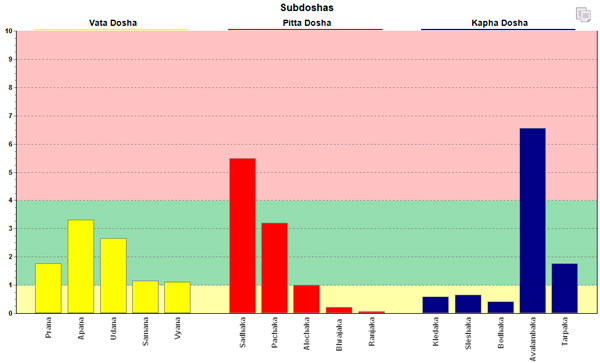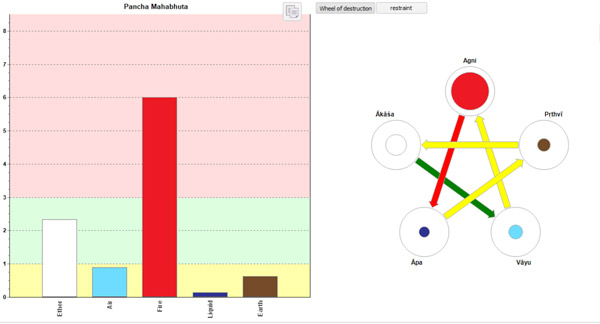Gallery
Functional Diagnosis (Nidana)
Functional Diagnosis (Nidana) module provides in-depth analysis of the root cause of the disease by assessing the functioning of the regulatory systems or Subdoshas, the state of tissues (Dhatu) and the balance of the five Primary elements (Pancha Maha Bhuta).
Functional diagnosis module is designed to help CAM practitioners conduct a multifactorial analysis of the client's condition, identify the root cause of a disorder and reverse the development of the disease while it's still at the level of functional disturbances, before systemic morphological changes (structural changes in organs and tissues) occur in the body. In case the disorder has crossed the line of structural changes, the module will be your tool to development a comprehensive recreation program.
Includes three tabs: "Subdosha", "Dhatu", "Pancha Maha Bhuta".
There are fifteen Subdoshas - five for each Maha (big) Dosha. Simply put, there are five types of Wind, five types of Fire, and five types of Water (Mucus/Phlegm).
1. SubDosha – analysis of thin components of human constitution
• 5 types of wind
Apana Vayu (descending nervous impulses), Samana Vayu (nervous system controlling digestion), Udana Vayu (cervical nervous plexus and phrenic nerve), Vyana Vayu (transfer of Prana and internal secretion), Prana Vayu (controls assimilation of Prana and tissue respiration)
• 5 types of fire
Pachaka Pitta (the fire of digestion), Ranjaka Pitta (the fire of blood, spleen and liver), Bhrajaka Pitta (the fire of the skin), Alochaka Pitta (the fire of vision), Sadhaka Pitta (the fire of mind).
• 5 types of water
Tarpaka Kapha (the fluid associated with the spinal spaces), Bodhaka Kapha (the fluid of oropharynx and ENT cavities), Sleshaka Kapha (the joint fluid), Avalambaka Kapha (the basic fluid medium of the body), Kledaka Kapha (the fluid of mucous membranes of the proximal gastrointestinal tract).

2.Dhatu
– energy and metabolic state of the tissues. Evaluation of level of Ama (metabolic waste) accumulation on srotas (channels of tissue supply).
- Rasa – blood plasma
- Rakta – cellular elements of the blood
- Mamsa – muscle tissue
- Meda – adipose tissue
- Asthi – bone tissue
- Majja – bone marrow, nervous tissue
- Shukra – reproductive tissue

3. PanchaMahaBhuta – the analysis of Primary elements balance in the body (ether – Akasha, air – Vayu, fire – Agni, water – Jala, earth – Prithvi) and their interrelationship (Wheel of Destruction and Restraint) as an equivalent of systemic regulation mechanisms. By analyzing the balance of main elements in the body, it is possible to find the initial cause of the imbalance of doshas, as each of them consists of 2 elements and each element’s imbalance should be approached differently.

- Login to post comments
User login
Last articles










